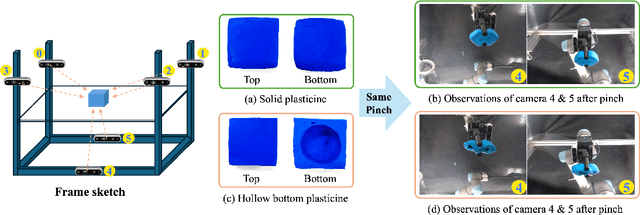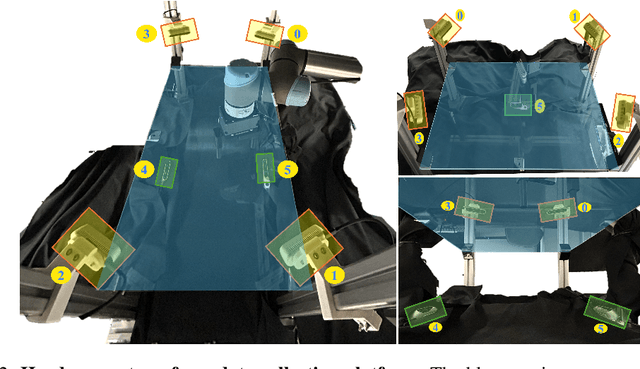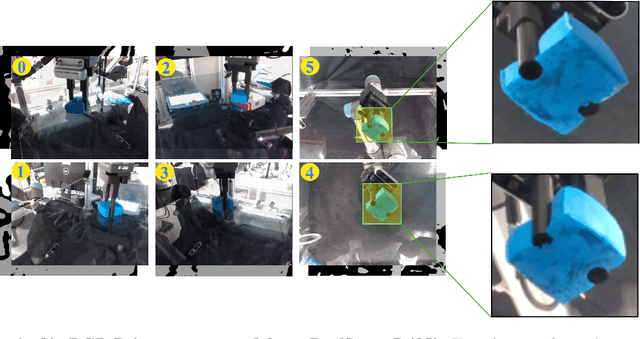Xiangyu Chu
Multiscale Medical Robotics Center, Hong Kong, China
Manipulating Elasto-Plastic Objects With 3D Occupancy and Learning-Based Predictive Control
May 22, 2025Abstract:Manipulating elasto-plastic objects remains a significant challenge due to severe self-occlusion, difficulties of representation, and complicated dynamics. This work proposes a novel framework for elasto-plastic object manipulation with a quasi-static assumption for motions, leveraging 3D occupancy to represent such objects, a learned dynamics model trained with 3D occupancy, and a learning-based predictive control algorithm to address these challenges effectively. We build a novel data collection platform to collect full spatial information and propose a pipeline for generating a 3D occupancy dataset. To infer the 3D occupancy during manipulation, an occupancy prediction network is trained with multiple RGB images supervised by the generated dataset. We design a deep neural network empowered by a 3D convolution neural network (CNN) and a graph neural network (GNN) to predict the complex deformation with the inferred 3D occupancy results. A learning-based predictive control algorithm is introduced to plan the robot actions, incorporating a novel shape-based action initialization module specifically designed to improve the planner efficiency. The proposed framework in this paper can successfully shape the elasto-plastic objects into a given goal shape and has been verified in various experiments both in simulation and the real world.
Learning to Hop for a Single-Legged Robot with Parallel Mechanism
Jan 21, 2025Abstract:This work presents the application of reinforcement learning to improve the performance of a highly dynamic hopping system with a parallel mechanism. Unlike serial mechanisms, parallel mechanisms can not be accurately simulated due to the complexity of their kinematic constraints and closed-loop structures. Besides, learning to hop suffers from prolonged aerial phase and the sparse nature of the rewards. To address them, we propose a learning framework to encode long-history feedback to account for the under-actuation brought by the prolonged aerial phase. In the proposed framework, we also introduce a simplified serial configuration for the parallel design to avoid directly simulating parallel structure during the training. A torque-level conversion is designed to deal with the parallel-serial conversion to handle the sim-to-real issue. Simulation and hardware experiments have been conducted to validate this framework.
DOFS: A Real-world 3D Deformable Object Dataset with Full Spatial Information for Dynamics Model Learning
Oct 29, 2024



Abstract:This work proposes DOFS, a pilot dataset of 3D deformable objects (DOs) (e.g., elasto-plastic objects) with full spatial information (i.e., top, side, and bottom information) using a novel and low-cost data collection platform with a transparent operating plane. The dataset consists of active manipulation action, multi-view RGB-D images, well-registered point clouds, 3D deformed mesh, and 3D occupancy with semantics, using a pinching strategy with a two-parallel-finger gripper. In addition, we trained a neural network with the down-sampled 3D occupancy and action as input to model the dynamics of an elasto-plastic object. Our dataset and all CADs of the data collection system will be released soon on our website.
Needle Segmentation Using GAN: Restoring Thin Instrument Visibility in Robotic Ultrasound
Jul 25, 2024Abstract:Ultrasound-guided percutaneous needle insertion is a standard procedure employed in both biopsy and ablation in clinical practices. However, due to the complex interaction between tissue and instrument, the needle may deviate from the in-plane view, resulting in a lack of close monitoring of the percutaneous needle. To address this challenge, we introduce a robot-assisted ultrasound (US) imaging system designed to seamlessly monitor the insertion process and autonomously restore the visibility of the inserted instrument when misalignment happens. To this end, the adversarial structure is presented to encourage the generation of segmentation masks that align consistently with the ground truth in high-order space. This study also systematically investigates the effects on segmentation performance by exploring various training loss functions and their combinations. When misalignment between the probe and the percutaneous needle is detected, the robot is triggered to perform transverse searching to optimize the positional and rotational adjustment to restore needle visibility. The experimental results on ex-vivo porcine samples demonstrate that the proposed method can precisely segment the percutaneous needle (with a tip error of $0.37\pm0.29mm$ and an angle error of $1.19\pm 0.29^{\circ}$). Furthermore, the needle appearance can be successfully restored under the repositioned probe pose in all 45 trials, with repositioning errors of $1.51\pm0.95mm$ and $1.25\pm0.79^{\circ}$. from latex to text with math symbols
World Models for General Surgical Grasping
May 28, 2024Abstract:Intelligent vision control systems for surgical robots should adapt to unknown and diverse objects while being robust to system disturbances. Previous methods did not meet these requirements due to mainly relying on pose estimation and feature tracking. We propose a world-model-based deep reinforcement learning framework "Grasp Anything for Surgery" (GAS), that learns a pixel-level visuomotor policy for surgical grasping, enhancing both generality and robustness. In particular, a novel method is proposed to estimate the values and uncertainties of depth pixels for a rigid-link object's inaccurate region based on the empirical prior of the object's size; both depth and mask images of task objects are encoded to a single compact 3-channel image (size: 64x64x3) by dynamically zooming in the mask regions, minimizing the information loss. The learned controller's effectiveness is extensively evaluated in simulation and in a real robot. Our learned visuomotor policy handles: i) unseen objects, including 5 types of target grasping objects and a robot gripper, in unstructured real-world surgery environments, and ii) disturbances in perception and control. Note that we are the first work to achieve a unified surgical control system that grasps diverse surgical objects using different robot grippers on real robots in complex surgery scenes (average success rate: 69%). Our system also demonstrates significant robustness across 6 conditions including background variation, target disturbance, camera pose variation, kinematic control error, image noise, and re-grasping after the gripped target object drops from the gripper. Videos and codes can be found on our project page: https://linhongbin.github.io/gas/.
Deformable Object Manipulation With Constraints Using Path Set Planning and Tracking
Feb 18, 2024



Abstract:In robotic deformable object manipulation (DOM) applications, constraints arise commonly from environments and task-specific requirements. Enabling DOM with constraints is therefore crucial for its deployment in practice. However, dealing with constraints turns out to be challenging due to many inherent factors such as inaccessible deformation models of deformable objects (DOs) and varying environmental setups. This article presents a systematic manipulation framework for DOM subject to constraints by proposing a novel path set planning and tracking scheme. First, constrained DOM tasks are formulated into a versatile optimization formalism which enables dynamic constraint imposition. Because of the lack of the local optimization objective and high state dimensionality, the formulated problem is not analytically solvable. To address this, planning of the path set, which collects paths of DO feedback points, is proposed subsequently to offer feasible path and motion references for DO in constrained setups. Both theoretical analyses and computationally efficient algorithmic implementation of path set planning are discussed. Lastly, a control architecture combining path set tracking and constraint handling is designed for task execution. The effectiveness of our methods is validated in a variety of DOM tasks with constrained experimental settings.
* 20 pages, 25 figures, journal
Bootstrapping Robotic Skill Learning With Intuitive Teleoperation: Initial Feasibility Study
Nov 11, 2023Abstract:Robotic skill learning has been increasingly studied but the demonstration collections are more challenging compared to collecting images/videos in computer vision and texts in natural language processing. This paper presents a skill learning paradigm by using intuitive teleoperation devices to generate high-quality human demonstrations efficiently for robotic skill learning in a data-driven manner. By using a reliable teleoperation interface, the da Vinci Research Kit (dVRK) master, a system called dVRK-Simulator-for-Demonstration (dS4D) is proposed in this paper. Various manipulation tasks show the system's effectiveness and advantages in efficiency compared to other interfaces. Using the collected data for policy learning has been investigated, which verifies the initial feasibility. We believe the proposed paradigm can facilitate robot learning driven by high-quality demonstrations and efficiency while generating them.
Interactive Navigation in Environments with Traversable Obstacles Using Large Language and Vision-Language Models
Oct 13, 2023Abstract:This paper proposes an interactive navigation framework by using large language and vision-language models, allowing robots to navigate in environments with traversable obstacles. We utilize the large language model (GPT-3.5) and the open-set Vision-language Model (Grounding DINO) to create an action-aware costmap to perform effective path planning without fine-tuning. With the large models, we can achieve an end-to-end system from textual instructions like "Can you pass through the curtains to deliver medicines to me?", to bounding boxes (e.g., curtains) with action-aware attributes. They can be used to segment LiDAR point clouds into two parts: traversable and untraversable parts, and then an action-aware costmap is constructed for generating a feasible path. The pre-trained large models have great generalization ability and do not require additional annotated data for training, allowing fast deployment in the interactive navigation tasks. We choose to use multiple traversable objects such as curtains and grasses for verification by instructing the robot to traverse them. Besides, traversing curtains in a medical scenario was tested. All experimental results demonstrated the proposed framework's effectiveness and adaptability to diverse environments.
End-to-End Deep Visual Control for Mastering Needle-Picking Skills With World Models and Behavior Cloning
Mar 07, 2023Abstract:Needle picking is a challenging surgical task in robot-assisted surgery due to the characteristics of small slender shapes of needles, needles' variations in shapes and sizes, and demands for millimeter-level control. Prior works, heavily relying on the prior of needles (e.g., geometric models), are hard to scale to unseen needles' variations. In addition, visual tracking errors can not be minimized online using their approaches. In this paper, we propose an end-to-end deep visual learning framework for needle-picking tasks where both visual and control components can be learned jointly online. Our proposed framework integrates a state-of-the-art reinforcement learning framework, Dreamer, with behavior cloning (BC). Besides, two novel techniques, i.e., Virtual Clutch and Dynamic Spotlight Adaptation (DSA), are introduced to our end-to-end visual controller for needle-picking tasks. We conducted extensive experiments in simulation to evaluate the performance, robustness, variation adaptation, and effectiveness of individual components of our method. Our approach, trained by 8k demonstration timesteps and 140k online policy timesteps, can achieve a remarkable success rate of 80%, a new state-of-the-art with end-to-end vision-based surgical robot learning for delicate operations tasks. Furthermore, our method effectively demonstrated its superiority in generalization to unseen dynamic scenarios with needle variations and image disturbance, highlighting its robustness and versatility. Codes and videos are available at https://sites.google.com/view/dreamerbc.
Towards Exact Interaction Force Control for Underactuated Quadrupedal Systems with Orthogonal Projection and Quadratic Programming
Oct 19, 2022



Abstract:Projected Inverse Dynamics Control (PIDC) is commonly used in robots subject to contact, especially in quadrupedal systems. Many methods based on such dynamics have been developed for quadrupedal locomotion tasks, and only a few works studied simple interactions between the robot and environment, such as pressing an E-stop button. To facilitate the interaction requiring exact force control for safety, we propose a novel interaction force control scheme for underactuated quadrupedal systems relying on projection techniques and Quadratic Programming (QP). This algorithm allows the robot to apply a desired interaction force to the environment without using force sensors while satisfying physical constraints and inducing minimal base motion. Unlike previous projection-based methods, the QP design uses two selection matrices in its hierarchical structure, facilitating the decoupling between force and motion control. The proposed algorithm is verified with a quadrupedal robot in a high-fidelity simulator. Compared to the QP designs without the strategy of using two selection matrices and the PIDC method for contact force control, our method provided more accurate contact force tracking performance with minimal base movement, paving the way to approach the exact interaction force control for underactuated quadrupedal systems.
 Add to Chrome
Add to Chrome Add to Firefox
Add to Firefox Add to Edge
Add to Edge